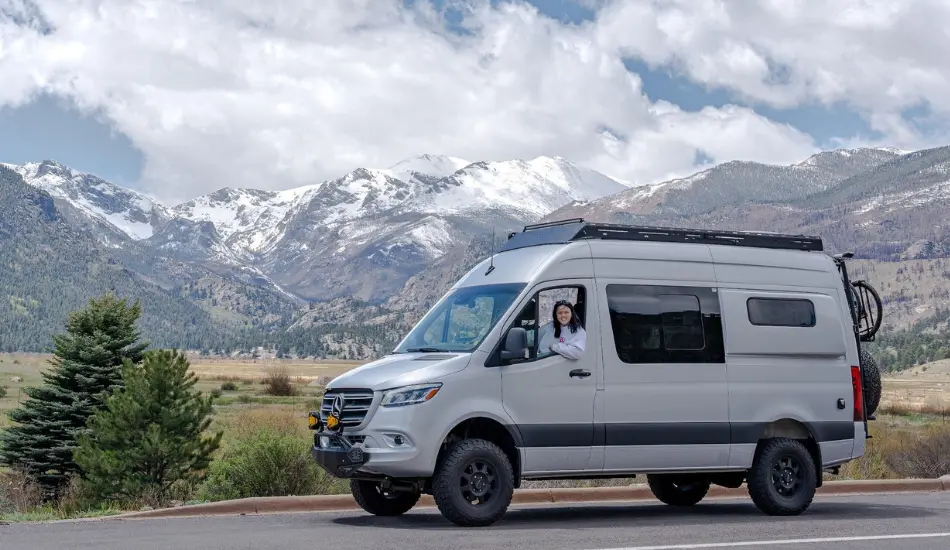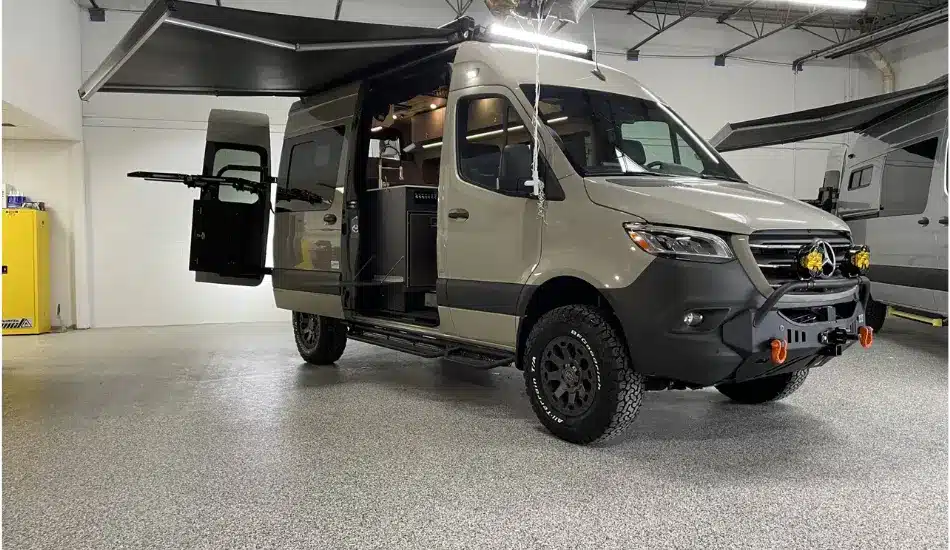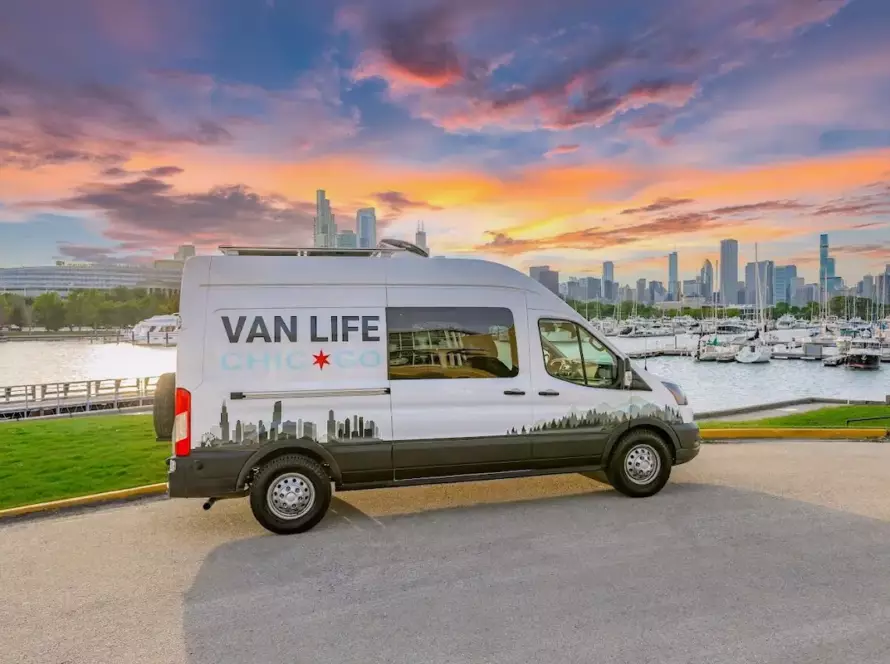The Campervan Roof is one of the most significant parts of your campervan. It helps keep your van comfortable in both hot and cold weather, shielding you from the sun and keeping you dry when it rains. This guide will cover all you need to know about campervan roofs. We will discuss the various kinds of roofs available, how to install them on your van, and how to maintain them over time. We’ll also give you some helpful tips on how to maximize the space on your camper van roof. Whether you’ve been camping for a long time or it’s your first time, this guide will provide all the information you need to ensure your campervan roof is functioning properly.
Types of Camper Van Roof
While investigating van roofs, you will find the low roof, hi-top, and pop-top roof as the three primary campervan roof options. Choosing any of these options has many benefits, but each has drawbacks. Here is a description of all three camper vans so it will be easy to select the best one.
Low Roof
Low-top conversion vans maintain the original van’s factory-made roof. They are typically more accessible to drive in stormy weather and have higher aerodynamic qualities.
These vans became less popular in the 1980s and 90s as people demanded larger interiors and entertainment systems. Such equipment was big and heavy back then, and low-top vans needed more space.
Pros:
- Increased fuel efficiency and airflow
- Fit in the majority of parking garages and garages of average size
- Easier to manage in harsh conditions like strong winds
Cons:
- People taller than five feet won’t be able to stand up in the van.
- There is less space inside overall than in high tops
Hi-Top Roof
High-top conversion vans have removed pieces of their original roof and replaced them with a fiberglass roof to raise the vehicle’s height. Because of this modification, the van’s interior has more space, enabling most passengers to move around while standing.
High tops are more common than low tops because they are more roomy and versatile. The primary uses for these vans are camper vans, office vans, and vans for disabled people.
Pros:
- Extra interior space
- Most occupants’ capacity to stand
- Wheelchair users won’t have to duck when entering.
- Additional choices for entertainment systems
Cons:
- It can be more challenging to control, particularly in windy conditions.
- Clearances that are too low for the van to fit could come up.
- Lower airflow conveys lower fuel efficiency.
Pop-Top Roof
A pop-top roof allows a van’s roof to extend into a tent, adding an extra bed to accommodate two people. A dropdown ladder inside the campervan can be used to access this.
Pop-top roofs are an excellent choice for anyone looking to fit three or four people comfortably in their campervan, including families with children.
These are frequently fitted to low-roof vans, allowing them to drive and park in places with less clearance when the pop-top is not in use.
Pros:
- These are ideal for entering narrow spaces.
- It might be inexpensive.
- It is suitable for daily use as a vehicle.
- This will give you a lot of flexibility.
Cons:
- When it’s open, it lacks insulation, making it unsuitable for chilly winter evenings.
- Every time you need more space, you have to set it up.
- The canvas provides less security for you.
- When stored improperly in a humid environment, the canvas may break down.
Roof-top Tent
A rooftop tent is an alternative van modification that offers additional sleeping space without the need for extensive alterations like cutting into the van’s structure. This tent is housed in a protective shell, which can be easily mounted on top of the van’s roof, making it a removable option if you decide to switch vehicles later. Rooftop tents are significantly more budget-friendly compared to other modifications, providing a cost-effective way to expand sleeping accommodations without encroaching on the van’s internal living area. They typically start as low as $3,000.
Advantages:
- It’s a more affordable option.
- Simple installation without permanent alterations to the van.
- Removable, making it versatile for use on different vehicles.
- Does not reduce interior space for daily activities.
Disadvantages:
- Offers limited insulation, which may not be ideal for cold weather.
- Requires setup and takedown each time it is used.
- Less secure, as it is only protected by the shell and canvas.
- Can suffer wear and tear if not stored properly in damp conditions.

Campervan Roof Materials
Nowadays, different kinds of materials are used for campervan roofs. The three primary materials used to make campervan ceilings are Aluminum, fiberglass, and rubber. Let’s know how these work for a campervan.
Rubber: An excellent, less expensive, and simple-to-maintain choice. Rubber roofs typically last 20 years or more, in certain situations, even 50 years, and are resistant to sun damage. One of their few drawbacks is that they could be more visually appealing and fade over time.
It’s also important to understand that rubber roofs come in two varieties: EPDM (Ethylene Propylene Diene Monomer) and TPO (Thermoplastic Polyolefin). Knowing which one is best for sustenance and repairs is very important.
Fiberglass: A typical long-lasting substance that gives roofs a sleek, glossy appearance. A fiberglass roof can last up to 20 years with proper maintenance, but it should last at least 10 years. It will be a more expensive investment if you’re looking for a fiberglass roof. It can also be challenging to mount objects on top of them.
Another drawback is that they can become extremely slippery when wet, so bear that in mind if you need to walk or climb on top of them.
Aluminum: When most people think of aluminum, they most likely think of the Airstream. Aluminum roofs are also possible for other campervans. This material withstands all kinds of weather conditions with excellent durability. Only a minor servicing is required.
Since aluminum roofs are the heaviest type available for campervans, replacing them to replace an existing roof can be challenging. Unfortunately, it can dent more quickly and is a more costly option.
Guide to Campervan Roof Conversions
The campervan roof is one of the most essential parts when considering turning a van into a campervan. This will transform the ordinary panel van into an exciting vehicle.
It’s among the conversion’s most costly and noticeable components. It’s necessary to conduct research before starting. Here are the steps, from the various kinds of roofs to the manufacturers and installers.
Can You Add a High Top to Your Van?
Adding a high top is an exciting experiment that can give your van more room and comfort for your travels. This step-by-step guide focuses on clarity to help you get started without problems.
Cutting a roof: once you begin, there’s no turning back. You must cut the roof to obtain the precise measurements for your frame.
Building The Frame: You must make the frame as soon as you have measurements. However, before you begin, you should choose the best materials. You can incorporate an exhaust fan and a skylight into your design if desired.
Fasten the frame: You should glue the frame to your van as soon as it’s constructed. The best kind of fastening that you can use are lag bolts.
Adding the exterior shell: When adding the outer shell, it’s best to do so after you’ve fastened the frame because you’ll have more space to work with than when you add the exterior walls first. For the same reason, you should wire in any electrical accessories before adding the walls.
Seal everything: The whole thing should be sealed if you want it to be weatherproof and watertight.
Can You Convert a Van to a Pop-Top?
Similar to installing a high top, you have two options for turning your van into a pop-top: hiring a professional or doing it yourself.
To access the pop-top, you will make a roof opening that you will enter from the inside rather than chopping off the entire roof. You can buy do-it-yourself kits, and several companies will even cut the opening in the ceiling for you.

How Much Does it Cost to Add a Pop-Top to a Campervan?
Whether you choose to do it yourself or hire a professional, adding a pop-top roof can have different costs. It’s simpler to add these upgrades to some vans than others. It also depends on the kind of pop-top you add and the kind of roof your van has.
You can add a pop-top at a relatively low cost and save a lot of money if you can find a used one for a very low price and do the installation yourself.
The expense of hiring a professional can range from $10,000 to $15,000. More options, like roof racks, four-season insulation, custom paint jobs, etc, frequently follow a base option.
Campervan Roof Maintenance Tips
When it comes to roofs, a campervan’s roof is one of its most essential features. Your camping trips will be more pleasant and comfortable with the extra headroom and sleeping space these campervan roofs offer.
But, to ensure longevity and trouble-free operation, your campervan roof needs routine care and maintenance, just like any other part.
Why Should You Take Care of Your Roof?
Maintaining the roof of your campervan will help you keep it running on the road smoothly. If you don’t maintain your roof, little issues may become more severe and require costly repairs.
Consider the roof of your campervan as a protective barrier. You are partially shielded from the elements by your roof. As it weathers the elements and protects you from wind, hail, and rain, your roof is built to last. Maintaining your roof will help to avoid major issues like mold and water damage.
Routine Inspection
It’s vital to understand the type of roof you have before beginning. Rubber, aluminum, vinyl, and many other materials could be used.
You should thoroughly inspect your roof as soon as you know its type. Check for damage indicators such as cracks and punctures. Examine the sealant surrounding skylights, vents, and other apertures for fractures, holes, peeling, or wear indicators.
Verify that there are no tearing issues along the edges and seams. If you discover problems, take quick action to stop more harm.
Routine Cleaning
It’s crucial to maintain a clean RV roof. Your RV’s interior may sustain damage, leaks, and eventual destruction due to a dirty roof. Make sure you have the appropriate cleaning supplies before you begin. Avoid using strong chemicals.
Rubber roofs are among the most popular types. You should use a cleaner specifically for RV roofs rather than regular household cleaners because these are chemically sensitive.
Conclusion
The value of an effective camper van roof in the context of outdoor activities cannot be overestimated. No matter the weather outside, it serves as a shield to keep you safe from the elements and ensure a comfortable voyage.
Only the best vans are delivered by Highland Vans since we take this factor carefully. We use state-of-the-art manufacturing technologies to create and manufacture our products carefully. Our roofs are the ideal traveling partner for anyone who desires to drive with assurance, as they ensure longevity, security, and tranquility. Remember that having a sturdy roof over your head is crucial when organizing your next journey. So, don’t hesitate to call us now.



